
These efforts are just wasting time as our economy continues to suffer. The present mindset in Congress, to simply cut spending and not increase taxes, misses the most important part of finding ways to improve our economy. This kind of dedicated support will result in continued economic growth for US manufacturing. Unlike the investment and banking industries, industries that manufacture products in the US, for not only US but world markets, need long-term incentives to develop new products and markets. Not only did the large corporations benefit, but the smaller feeder industries that made parts and components also flourished.Ĭongress should seriously revisit this program, look at how it would enhance US business and the US economy, and make it part of new economic legislation moving through Congress at this time. This industrial IRAD work was supported by R&D cost recovery, not a bailout, for business to perform or extend the required fundamental research, and then develop and manufacture new products, US products. Foreign countries subsequently picked up the R&D and manufacturing work that we either gave them through outsourcing or let them have outright. In this atmosphere, the great research laboratories, for example those run by GE, Bell, RCA, Westinghouse, ITT and many others, were shut down, and key new product development at US corporations either disappeared completely or declined to the low levels that we have today. This was a win/win program for both the federal government and business because it nourished new product development and manufacturing in the USA.Īfter decades of outstanding contributions to our economy, the federal government cut back IRAD programs, and there was uncertainty about the long-term commitment to support them. As a Technical Director I was responsible for many IRAD projects while working for several major US corporations. It allowed industry to recover costs for doing research and development that was in the interest of the government as well as business. The YAL-1A Airborne Laser Test Bed aircraft was ferried to Davis Monthan Air Force Base, Arizona where it was placed in storage at the Air Force's Aerospace Maintenance and Regeneration Group.Incentives Can Re-invigorate US ManufacturingĪ government program called the Independent Research and Development Program (IRAD) was very strong and effective until the mid-1990s. The program was terminated due to budget reductions on 14 February 2012. In 2011 funding was eliminated as the program was eight years behind schedule and it had a staggeringly large budget of $500 million per year. However, in that same year the device failed two tests in a row. This resulted in the program receiving an additional $40 million in funding even though the Secretary of Defense himself admitted it was not realistic. In 2010, the ALTB successfully knocked a "threat representative" missile out of flight from a distance of 50 miles. In January 2010, the high energy laser was fired to intercept a test Missile Alternative Range Target Instrument (MARTI). The YAL 1A laser travels at the speed of light to destroy ballistic missiles in their boost phase of flight. The YAL-1A is a prototype that employs a highly modified Boeing 747-400 airframe equipped with sensors, lasers and sophisticated optics to find, track and destroy ballistic missiles in their boost, or ascent, phase. The ABL was an airborne-directed energy weapon system. It was reactivated in 2006 and performed ground and flight testing on the Boeing YAL-1A until 2010, before that program was cancelled. The squadron conducted flight testing of the McDonnell Douglas C-17 Globemaster III until it was inactivated in 1995 as the 417th Test Squadron. It is assigned to the 96th Operations Group at Eglin Air Force Base, Florida, where it was reactivated on 17 April 2019. The 417th Flight Test Squadron is an active United States Air Force squadron. When fired, the laser used enough energy in a five-second burst to power a typical American household for more than an hour. The heart of the system was the COIL, comprising six interconnected modules, each as large as an SUV.Įach module weighed about 6,500 pounds (3,000 kg). The aircraft was designated YAL-1A in 2004 by the U.S.

It was primarily designed as a missile defense system to destroy tactical ballistic missiles (TBMs) while in boost phase. Boeing's Laser Jet can take out targets 50 miles away (like Chyna EMP balloons) but was cancelled✈️🎈💰The Boeing YAL-1 Airborne Laser Testbed (formerly Airborne Laser) weapons system was a megawatt-class chemical oxygen iodine laser (COIL) mounted inside a modified military Boeing 747-400F.


 0 kommentar(er)
0 kommentar(er)
